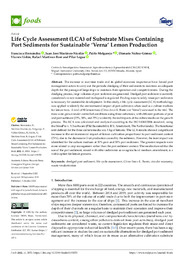Por favor, use este identificador para citar o enlazar este ítem:
https://hdl.handle.net/11000/34463Registro completo de metadatos
| Campo DC | Valor | Lengua/Idioma |
|---|---|---|
| dc.contributor.author | Hernández, Francisca | - |
| dc.contributor.author | Martínez Nicolas, Juan José | - |
| dc.contributor.author | Melgarejo Moreno, Pablo | - |
| dc.contributor.author | Núñez-Gómez, Dámaris | - |
| dc.contributor.author | Lidón Noguera, Vicente | - |
| dc.contributor.author | Legua, Pilar | - |
| dc.contributor.author | Legua, Pilar | - |
| dc.contributor.other | Departamentos de la UMH::Producción Vegetal y Microbiología | es_ES |
| dc.date.accessioned | 2025-01-15T09:18:35Z | - |
| dc.date.available | 2025-01-15T09:18:35Z | - |
| dc.date.created | 2022-10 | - |
| dc.identifier.citation | Foods 2022, 11, 3053. | es_ES |
| dc.identifier.issn | 2304-8158 | - |
| dc.identifier.uri | https://hdl.handle.net/11000/34463 | - |
| dc.description.abstract | The increase in maritime trade and its global economic importance have forced port management actors to carry out the periodic dredging of their sediments to maintain an adequate depth for the passage of large ships to maintain their operation and competitiveness. During the dredging process, large volumes of port sediment are generated. Dredged port sediment is currently considered a waste material and its disposal is regulated. Finding ways to safely reuse port sediments is necessary for sustainable development. In this study, a life cycle assessment (LCA) methodology was applied to identify the environmental impact of port sediments when used as a culture medium for lemon trees. A total of 90 lemon trees (Citrus limon L. Burm var ‘Verna’) were used in the trial. The trees were grown under controlled conditions using three substrates, with different portions of peat and port sediment (25%, 50%, and 75%) to identify the real impacts of the culture media on the growth process. The LCA was calculated and analyzed according to the ISO 14040:2006 standard, using the SimaPro v. 9.3 software (PRé Sustainability B.V, Amersfoort, The Netherlands). The functional unit defined for the three-culture media was 1 kg of lemons. The LCA results showed a significant increase in the environmental impact of lemon cultivation proportional to port sediment content (75%), due to the decrease in fruit production caused by the sediment. However, the least impact was identified for the culture medium at 50% peat and 50% port sediment. The greatest impacts were more related to crop management rather than the port sediment content. The results showed that the use of the port sediment, mixed with other substrates as an agricultural medium amendment, is a viable option for lemon growers. | es_ES |
| dc.format | application/pdf | es_ES |
| dc.format.extent | 13 | es_ES |
| dc.language.iso | eng | es_ES |
| dc.publisher | MDPI | es_ES |
| dc.rights | info:eu-repo/semantics/openAccess | es_ES |
| dc.rights | Attribution-NonCommercial-NoDerivatives 4.0 Internacional | * |
| dc.rights.uri | http://creativecommons.org/licenses/by-nc-nd/4.0/ | * |
| dc.subject | dredged port sediment | es_ES |
| dc.subject | life cycle assessment | es_ES |
| dc.subject | Citrus limon L. Burm | es_ES |
| dc.subject | circular economy | es_ES |
| dc.subject | waste revalorization | es_ES |
| dc.title | Life Cycle Assessment (LCA) of Substrate Mixes Containing Port Sediments for Sustainable ‘Verna’ Lemon Production | es_ES |
| dc.type | info:eu-repo/semantics/article | es_ES |
| dc.relation.publisherversion | https:// doi.org/10.3390/foods11193053 | es_ES |

Ver/Abrir:
foods-11-03053.pdf
982,16 kB
Adobe PDF
Compartir:
 La licencia se describe como: Atribución-NonComercial-NoDerivada 4.0 Internacional.
La licencia se describe como: Atribución-NonComercial-NoDerivada 4.0 Internacional.
.png)